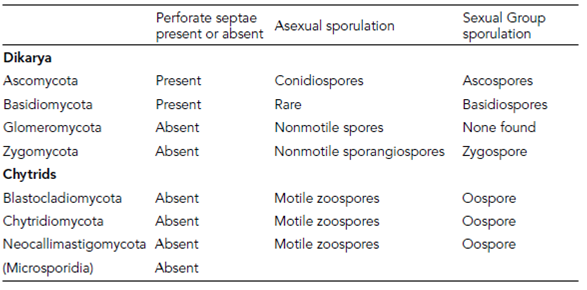Fungal taxonomy
In the past the fungi were a polyphyletic group that contained microorganisms that had very different ancestors. Current thinking now prefers a monophyletic classification where all groups within a phylum are descendants of one ancestor.
Fungal taxonomy is currently undergoing a comprehensive review based on molecular data and phylogenetic analysis. The fungi currently contain around 70 000 described species, with an estimated 1.5 to 4 million fungi as yet undescribed. They are now considered to be a member of the eukaryotic crown, evolving about a billion years ago as a sister clade to the Animals.The original classification of the fungi into four major phyla based largely on form groups is now being replaced with a classification that includes one sub-kingdom, the Dikarya, which contains the phyla the Ascomycota and Basidiomycota. These are fungi with complex mycelium with elaborate, perforate septa and a complex life cycle that includes a phase where a pair of unfused nuclei exists together in one cell (the dikaryon).
Up to seven other phyla are proposed, including the Glomeromycota, and the Zygomycota, fungi with nonseptate mycelium, asexual sporangiospores, and sexual zygospores (grouped together in the Zygomycetes in the old system) and three phyla containing the fungi with motile spores, the Blastocladiomycota, Chytridiomycota, and Neocallimastigomycota. This group is loosely termed the chytrids.
However, it seems that neither the Zygomycota nor the Chytridiomycota are monophyletic and the phyla may yet be deconstructed as data accumulate. Two chytrids in particular illustrate the difficulty in developing a classification for this group. Rozella is an intracellular parasite of other chytrid fungi with an extremely reduced thallus, which appears to have diverged very early from the main fungal branch. From recent molecular data it appears to be a sister group to the Microsporidia, until very recently considered being a member of the animal kingdom. Olpidium, a fungus with a growth habit very like that of Rozella as an intracellular parasite, appears to have evolved a lot later than most of the chytrids and may be closer to the Zygomycetes.A more startling change is the inclusion of the microsporidia in the fungi. These are obligate, highly specialized intracellular parasites, and about 1300 described species, infecting animals, humans, insects, and fish. Originally described as schizomycete fungi, then placed at the base of the eukaryote tree, as amitochondrial primitive species, molecular data now find them within the fungal branch of the eukaryotic tree.
Within each of the major phyla are several classes of fungi, indicated by names ending with -etes, and within classes can be subclasses or orders, indicated by names ending in -ales, within which there are genera and then species. The important differences between fungi used to distinguish taxonomic groups are summarized in Table 1.
Table 1. Features of the main groups of fungi
